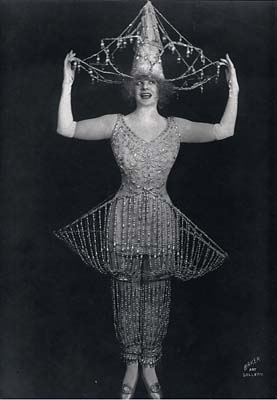The Night Eva Tanguay Rang Down the Curtain in Fairmont
By Raymond Alvarez

Eva Tanguay in Ziegfeld’s Follies, ca. 1909. Photo by Baker’s Art Gallery, Columbus, Ohio.
Vaudeville, the most popular form of theater the early 20th century, was usually a hodgepodge of unrelated comedy and musical acts grouped together on a common bill. Actors and musicians toured small towns, giving Americans an hour or two escape from their everyday lives for a dime or a quarter. Some audience members also took it as an invitation to “act up.”
Fairmont had two vaudeville houses. The Grand Opera House on Jackson and Monroe streets was touted as “the finest amusement edifice in West Virginia” when it opened in January 1902. The West Virginian newspaper announced its much anticipated arrival: “Before the curtain rises on opening night, there will have been between $60,000-70,000 spent on the construction of this Thespian temple.”
The building featured 1,260 seats, a bowl floor, orchestra circles, 14 boxes, the balcony and gallery, a ladies’ parlor, toilet rooms, a manager’s office, check rooms, and anterooms. Dressing rooms and the orchestra room were located below the 33’ x 62’ stage. The theater was equipped with fly galleries and rigging for scene changes, storerooms, and a “most modern switch board for stage purposes complete with a set of dimmers.” The building had more than 500 electric and gaslight fixtures. The interior was tinted stucco, and the exterior was buff brick and stone. Colored art glass was used in the building’s many round windows. A series of fire escapes allowed patrons to exit “in less than two minutes.” A porte cochere extended over the sidewalk at the main entrance on Monroe Street.
The theater was the brainchild of several local businessmen: L. J. Thomas Miller, M. A. Joliff (sheriff), Sam R. Nuzum, E. F. Hartley, John A. Clark Sr., A. A. Hamilton, L. C. Powell (editor of the West Virginian); and L. S. Horner (manager of Clarksburg’s opera house). Fairmont’s T. L. Burchinal constructed the building based on designs by Pittsburgh architect J. E. Allison.
According to newspapers, Fairmont’s Grand Opera House aimed to attract “the best of high class theatrics to Fairmont.” And it was feasible to bring production companies, actors, and large elaborate sets to small towns—even for one night—thanks to the spread of railroads. Fairmont’s Grand Opera House was located only a few blocks uphill from the train station.
In 1952, C. E. “Ned” Smith, longtime editor of the Fairmont Times, recalled the early years of vaudeville in town: “Back in those days Fairmont did not seem to be so far off the beaten path. With no radios, movies or automobiles, we seem to have done pretty well. Having two or three big shows in town every week, we did not feel that to find the world we had to go out and look for it, but that the world, especially the world of glamour, was knocking at our door.”
He recalled a particular controversy at the newly opened Grand Opera House. Smith, who was in college at the time, observed the affair on January 14, 1902—the memorable day Eva Tanguay and an entourage of New York actors arrived to perform “The Chaperons,” a two-act musical variety show with 41 performers. With book and lyrics by Frederic Ranken and score by George Lederer, it was billed as a “spectacle, opera, farce, ballet and vaudeville in one great entertainment.” Tickets—priced at $1.50, $ .75, and $ .25—went on sale January 12.
The newspaper featured photos of Eva Tanguay and lead actor Walter Jones. It noted that the play’s scenery could be described as “sumptuous even in these days of extravagant stage presentation.”
Eva Tanguay, 24 at the time, was just beginning to make a name for herself beyond New York City. Before she was done, she’d become one of the greatest vaudeville stars in history. Later known as the “I Don't Care Girl” for a brash song she popularized, the trailblazing artist shattered stereotypes as a boldly sensual entertainer. She was one of the first vaudevillians to achieve mass-media celebrity and was escorted by a cadre of publicists, who trumpeted her on- and off-stage successes and outrages.
You can read the rest of this article in this issue of Goldenseal, available in bookstores, libraries or direct from Goldenseal.